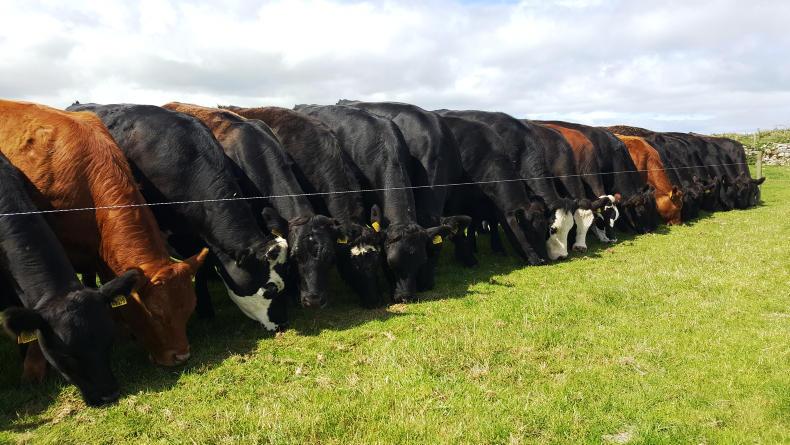Calving recently commenced on the farm, getting off to a bang with a set of twins. A pair of Salers heifers, born unassisted and up sucking in no time. The cow carried 274 days in-calf and calved a month earlier than in 2017. All calves so far, have been born outside and only one needed some assistance.
Calving outside has great advantages, including not needing to worry about hygiene and naval infections, calves quicker to their feet, not slipping and tripping in straw bedding and cows with clean elders allowing calves to suck without taking in some sort of infection which could lead to a case of scour.
Cows are fitter too, due to more walking around, which should help when it comes to calving. I have also chosen bulls with a low rating for calving difficulty this year, to keep calving as simple as possible.
Once calved, the calf is tagged and measured around the chest girth and height at the shoulder. This must all be done with safety in mind - if the cow is protective and dangerous then the cow and calf must be separated to do these jobs safely.
I would like to be weighing all calves at birth, however as they are calving outside, I don’t want to add stress to the cow and calf by bringing them into a yard for weighing. Cows calving later in the season maybe housed for calving and these calves will be weighed as they are born.
Grass
July was a tough month for grazing. While keeping the in-calf cows tight on grass was not a problem, the youngstock and the beef heifers needed good grass in front of them to keep thriving. At the start of July, grass ran out in front of the beef heifers, silage bales and meal had to be introduced and the stocking rate had to be reduced by bringing indoors a group of heifers that were closest to finishing.
While some of these heifers were fit for slaughter immediately, the remainder will be fed silage and meal indoors to be finished during August.
Second-cut silage has been saved and that should complete the winter requirements. Now that all silage fields are available for grazing and grass growth rates are picking up again, I will be able to build grass covers for the recently calved cows and young calves.
The aim for the next couple of months is to complete the calving season with as little hassle as possible, have cows ready for the breeding season and have calves as heavy and strong as possible before housing.
Read more
'A famine is what we are facing' – Corkman feeding silage for seven weeks
Western farmers stockpile fodder for winter with third cuts
Calving recently commenced on the farm, getting off to a bang with a set of twins. A pair of Salers heifers, born unassisted and up sucking in no time. The cow carried 274 days in-calf and calved a month earlier than in 2017. All calves so far, have been born outside and only one needed some assistance.
Calving outside has great advantages, including not needing to worry about hygiene and naval infections, calves quicker to their feet, not slipping and tripping in straw bedding and cows with clean elders allowing calves to suck without taking in some sort of infection which could lead to a case of scour.
Cows are fitter too, due to more walking around, which should help when it comes to calving. I have also chosen bulls with a low rating for calving difficulty this year, to keep calving as simple as possible.
Once calved, the calf is tagged and measured around the chest girth and height at the shoulder. This must all be done with safety in mind - if the cow is protective and dangerous then the cow and calf must be separated to do these jobs safely.
I would like to be weighing all calves at birth, however as they are calving outside, I don’t want to add stress to the cow and calf by bringing them into a yard for weighing. Cows calving later in the season maybe housed for calving and these calves will be weighed as they are born.
Grass
July was a tough month for grazing. While keeping the in-calf cows tight on grass was not a problem, the youngstock and the beef heifers needed good grass in front of them to keep thriving. At the start of July, grass ran out in front of the beef heifers, silage bales and meal had to be introduced and the stocking rate had to be reduced by bringing indoors a group of heifers that were closest to finishing.
While some of these heifers were fit for slaughter immediately, the remainder will be fed silage and meal indoors to be finished during August.
Second-cut silage has been saved and that should complete the winter requirements. Now that all silage fields are available for grazing and grass growth rates are picking up again, I will be able to build grass covers for the recently calved cows and young calves.
The aim for the next couple of months is to complete the calving season with as little hassle as possible, have cows ready for the breeding season and have calves as heavy and strong as possible before housing.
Read more
'A famine is what we are facing' – Corkman feeding silage for seven weeks
Western farmers stockpile fodder for winter with third cuts






 This is a subscriber-only article
This is a subscriber-only article












SHARING OPTIONS: